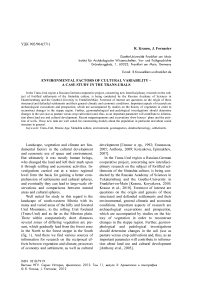Environmental factors of cultural variability - a case study in the Trans-Urals
Автор: Краузе Р., Форнасье Й.
Журнал: Вестник Новосибирского государственного университета. Серия: История, филология @historyphilology
Рубрика: Культурная вариативность на археологических памятниках Урала и западной Сибири в эпоху Палеометалла
Статья в выпуске: 3 т.11, 2012 года.
Бесплатный доступ
In the Trans-Ural region a Russian-German cooperative project, concerning new interdisciplinary research on the subject of fortified settlements of the Sintashta culture, is being conducted by the Russian Academy of Sciences in Ekaterinenburg and the Goethe-University in Frankfurt/Main. Foremost of interest are questions on the origin of these structured and defended settlements and their general climatic and economic conditions. Important aspects of research are archaeological excavations and prospection, which are accompanied by studies on the history of vegetation in order to reconstruct changes in the steppe region. Further, geomorphological and pedological investigations should determine changes in the soil (use as pasture versus crop cultivation) and, thus, as an important parameter will contribute to information about land use and cultural development. Recent magnetogramms and excavations show houses` plans and the position of wells. These new data are well suited for constructing models about the population in particular and about social structure in general.
Trans-ural, bronze age, sintashta culture, environment, geomagnetics, dendrochronology, settlements
Короткий адрес: https://sciup.org/14737754
IDR: 14737754 | УДК: 902/904(571)
Текст научной статьи Environmental factors of cultural variability - a case study in the Trans-Urals
Landscape, vegetation and climate are fundamental factors in the cultural development and economic use of space and environment. But ultimately it was mostly human beings, who changed the land and left their mark upon it through settling and economic activities. Investigations carried out at a micro regional level form the basis for gaining a better comprehension of settlements and cultural spheres, and eventually they can lead to large-scale observations and comparisons between natural areas and cultural spheres.
Well suited for study in this regard is the landscape of south-western Siberia with its many and varied areas of the hilly and forested Ural Mountains, to the rolling Ural foreland (Trans-Ural) and as far as the Siberian plain. There within comparatively short distances several zones of differing vegetation are present, which gradually lead from the forest zone in the North to the forest steppe in the South (fig. 1). And there we find various sources of information for research on the reciprocal effects between vegetation and climate, processes of economy and settlement, as well as cultural development [Генинг и др., 1992; Епимахов, 2005; Anthony, 2009; Koryakova, Epimakhov, 2007].
In the Trans-Ural region a Russian-German cooperative project, concerning new interdisciplinary research on the subject of fortified settlements of the Sintashta culture, is being conducted by the Russian Academy of Sciences in Yekaterinburg and the Goethe-University in Frankfurt-on-Main [Krause, Koryakova, 2010; Krause et al., 2010]. Foremost of interest are questions on the origin and genesis of these structured and defended settlements and their environmental, general climatic and economic conditions. Important aspects of research are archaeological excavations and prospection, which are accompanied by studies on the history of vegetation in order to reconstruct changes in the steppe region. Further, geomorphological and pedological investigations should determine changes in the soil (use as pasture versus crop cultivation) and, thus, as an important parameter will contribute to information about land use and cultural development [Anthony et al., 2005].
ISSN 1818-7919
-естнЁ^ НГ”. —ерЁя: »сторЁЯ, Фёлоло„ёя. 2012. “ом 11, ,ыпyc^ 3: Археоло„ЁЯ ё этно„рафЁЯ © R. Krause, J. Fornasier, 2012
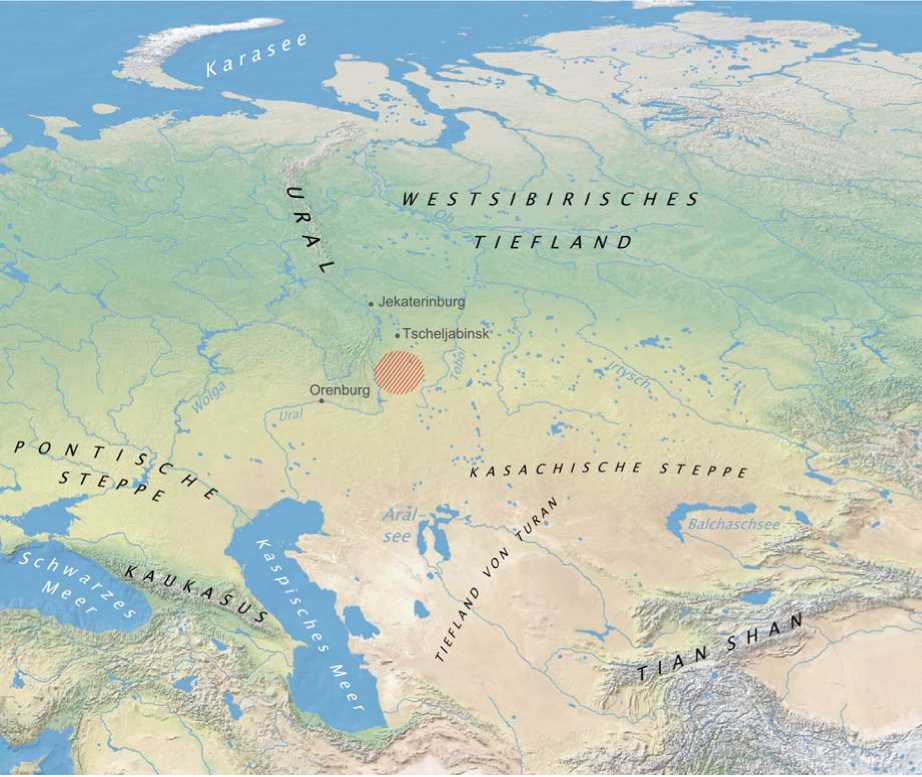
Fig. 1. Map of Trans-Ural and Western Siberia with study area between the Ural and Tobol rivers (based on map from Natural Earth, arranged by D. Knoll)
One of the principal regions of Eurasia today, the Urals and foreland are of great importance due to the rich minerals and ores found there [Черных, 2007; Zaykov et al., 2005; Chernych, 2002; Hanks, Doonan, 2009]. Yet, the copper ores played a decisive role already in the Bronze Age, and metallurgy and metalworking came to flourish there. The best known example of this early development is the exploitation of copper ores during the late Bronze Age evidenced at Kargaly, district of Orenburg, at the southern end of the Urals [Черных, 2007]. Ore deposits and Bronze Age exploitation are also known in the eastern Ural foreland, for example, the large opencast pit ( Pinge ) at Vorovskaya Yama [Zaykov et al., 2005. P. 104]. There copper was mined during the time of the Sintashta culture, as proven by archaeological excavations.
The fortified settlements lie mainly in the lowlands along smaller rivers; the majority was built at a distance of 25 to 30 km from one another [Krause et al., 2010. S. 99. Fig. 3; Koryakova, Epimakhov, 2007. P. 68]. They range in size from one to four hectares. However, despite this regularity there are some noteworthy exceptions. In contrast to the usual distance of up to 30 km, in the area under study in our project – along the small river Karagaily-Ayat – are three settlements that are located in less than 10 km from one another: Kamennyi Am-bar (Olgino), Zhurumbai and Konoplyanka (fig. 2).
Research particularly in this region has enabled unique insight into human use of spatial conditions afforded by nature there. So here the following questions are asked: Were these three settlements contemporary or did they exist suc- cessively? Because of their special location, is it possible that they even formed a larger, perhaps economic unit?
One of the main goals of our research project is to resolve these theses, above all, whether further undefended habitations lay in the vicinity of the respective main settlement and thus formed a settlement unit. Preliminarily, the general opinion in research is that in all probability we have here socio-economically and politically independent units or central lo- calities, whose basic common traits are found in comparable cultural customs and in the use of the same technologies, especially metallurgy [Koryakova, Epimakhov, 2007. P. 86–96]. It becomes clear that the new model of a fortified settlement is a fully novel form of architecture in the steppe, which surely reflects new forms of social organisation. For how else could such a complex settlement structure have been assumed from other regions, further developed and operated there, if not through
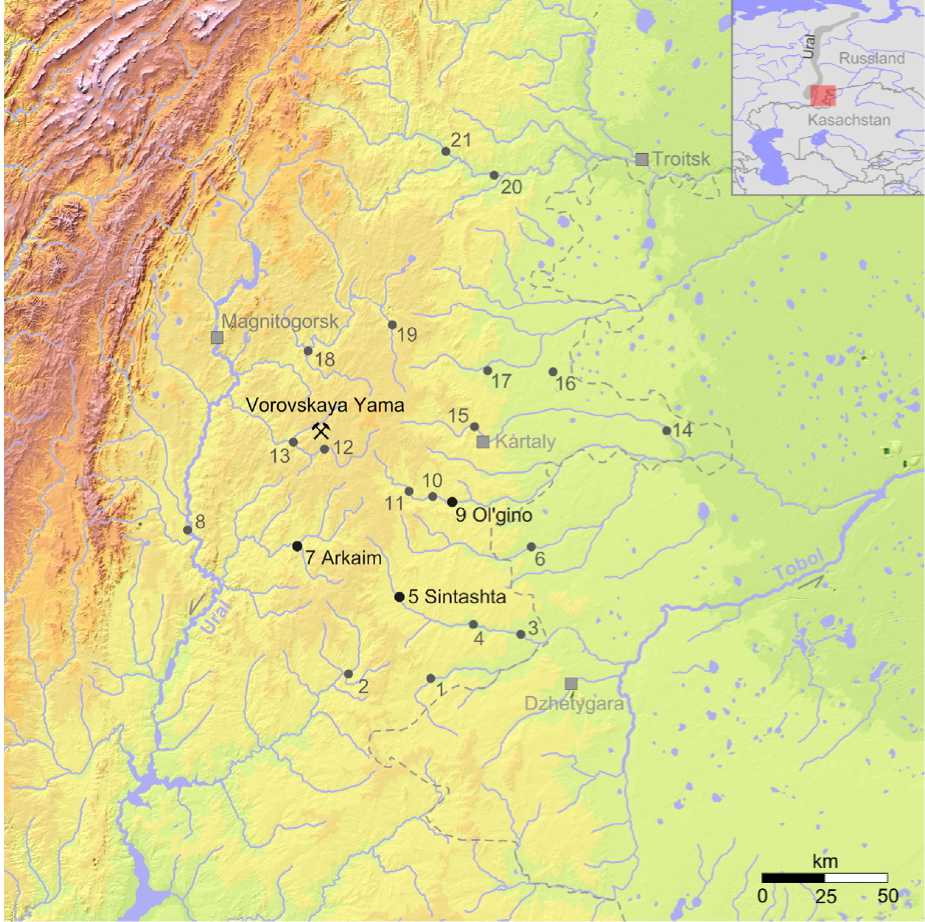
Fig. 2. Fortified settlements of the Sintashta culture: 1 – Stepnoe; 2 – Chernorech’e III; 3 – Bachta; 4 – Pariz (Astaf’evskoe); 5 – Ust’e; 6 – Chekataj; 7 – Kujsak; 8 – Sarym-Sakly; 9 – Rodniki; 10 – Isinej; 11 – Konopljanka; 12 – Žurumbaj; 13 – Kamennyj Ambar (Olgino); 14 – Kizil’skoe; 15 – Arkaim; 16 – Kamysty; 17 – Sintashta; 18 – Sintashta 2 (Levoberezhnoe); 19 – Andreevskoe; 20 – Alandskoe; 21 – Bersuat (Map by D. Knoll, after [Зданович, Батанина, 2007. Рис. 1]; orientation of the north)
Landscape and space

Fig. 3 . A model of possible socio-cultural influences between the settlement areas
a firmly organised and – above all, systematically conducted communal effort? It is no coincidence that it is repeatedly suggested in research that the appearance of these settlements was accompanied by a growing control over the territory, a control whose aggressive character is already expressed in the presence of fortifications and by the warriors buried under kurgans [Anthony, 2009. P. 54].
It is therefore an important challenge for our project to clarify the socio–cultural organisation of fortified settlements and the question as to whether they stood independently or were linked through a political umbrella organisation. Namely, there must have been a sizable potential in population next to and outside of the fortified settlements that inhabited the space outside in different ways and forms. Or, as a credible alternative model, nomadic or transhumant ways of life existed in the surrounding of central fortified settlements (fig. 3). The excavations conducted by Russian colleagues in Olgino since 2005 have brought forth large amounts of new data as well as new or modi- fied lines of inquiry, which our project has made use of since 2008 [Krause, Koryakova, 2010; Krause et al., 2010]. In cooperation with our Russian colleagues we have carried out numerous natural scientific investigations in addition to excavations (see Kalis, Stobbe this volume).
An invaluable component of research on monuments of the Sintashta period is the analysis of aerial photographs made by the geologist I. M. Batanina (2011). Through her year-long assiduous work in the 1990s, she basically laid the foundation for our present state of knowledge [Зданович, Батанина, 2007]. Thanks to her work, until now we could identify at least 21 fortified settlements from this specific time. All of these sites are concentrated in the northern steppe of the southern Trans-Urals, between the Tobol and Ural rivers, in an area of ca. 200 x 300 km.
Basing upon the results of archaeological aerial photography, the Russian-German cooperation has paved new ways for the study of cultural remains in the Trans-Urals. For exam- ple, we carried out a spatial evaluation of archaeological contexts using a geo-informationsystem (GIS). Our aim thereby is a systematic and precise investigation of the spatial association of archaeological data as well as contexts determined by methods of the natural sciences, an objective that is really pioneer work in the southern Urals. Known findings as well as newly recognised archaeological contexts are integrated in a digital hierarchical GIS databank and studied with the help of GIS analyses. The computer-supported archaeological longdistance exploration is continued with the aid of a broad spectrum of aerial and satellite images of various features. In this aspect, the combination of various satellite images, in particular, has proven quite advantageous, as it offers a look back at the state of the original landscape, on the one hand, while, on the other, enabling the exact localisation and multi-spectral analysis of contexts in the present-day situation.
The area under study lies along the river Karagaily-Ayat (fig. 4) on the border of the so called forest steppe. This zone is characterised by a continental climate with large precipitation at the boundary to the forest line and by high evaporation rates during vegetation periods due to the temperature and wind. The dominant vegetation in the area under study is the feather-grass-steppe. However, due to anthropogenic influence, today this colourful and floral feather-grass-steppe is present only in small areas. Oppositely, different states of degradation are far more prevalent, such as the different kinds of goose-foot (Chenopodiaceae family). Similarly, the groves of birch trees in hollows and eroded gullies are pervaded by species from the steppe and indicators of pasturage.
The topography of the settlement of Kamen-nyi Ambar itself, situated some 2,5–3 m above the flood land of the river, is almost a horizontal plane and displays only a weak structure in relief. The site measures 130 m in length in north-south direction with a difference in height of merely one metre, that is to say, the area is more or less level.
The fortified settlement of Kamennyi Am-bar displays a rectangular form, 115 x 155 m, with round ends, whereby the surface area within the fortification covers ca. 18,000 m2.
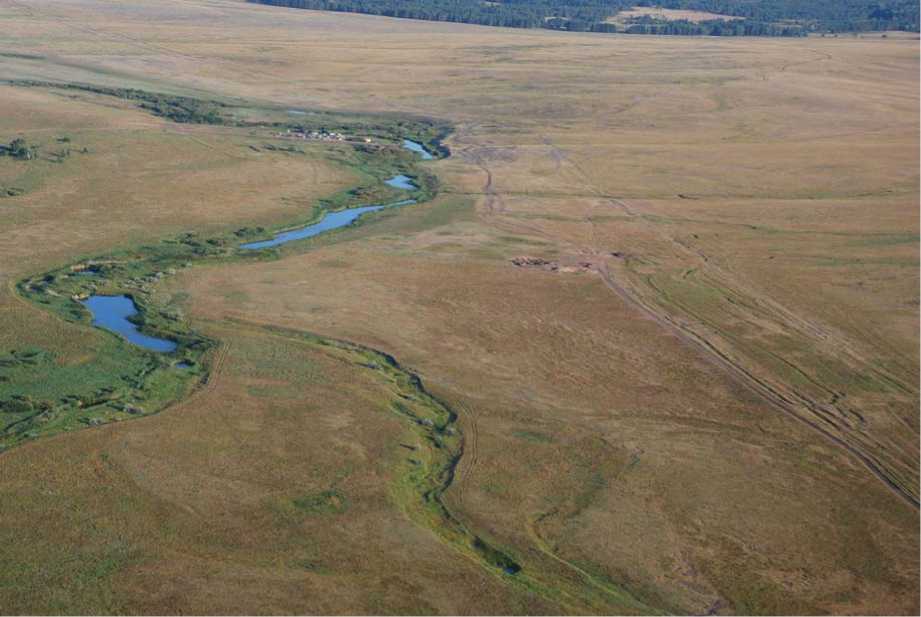
Fig. 4 (photo). The vast valley of river Karagaily-Ayat (near the center lies the Kamennyi Ambar settlement and the excavation site, a cooperative project of Russian and German scientists)
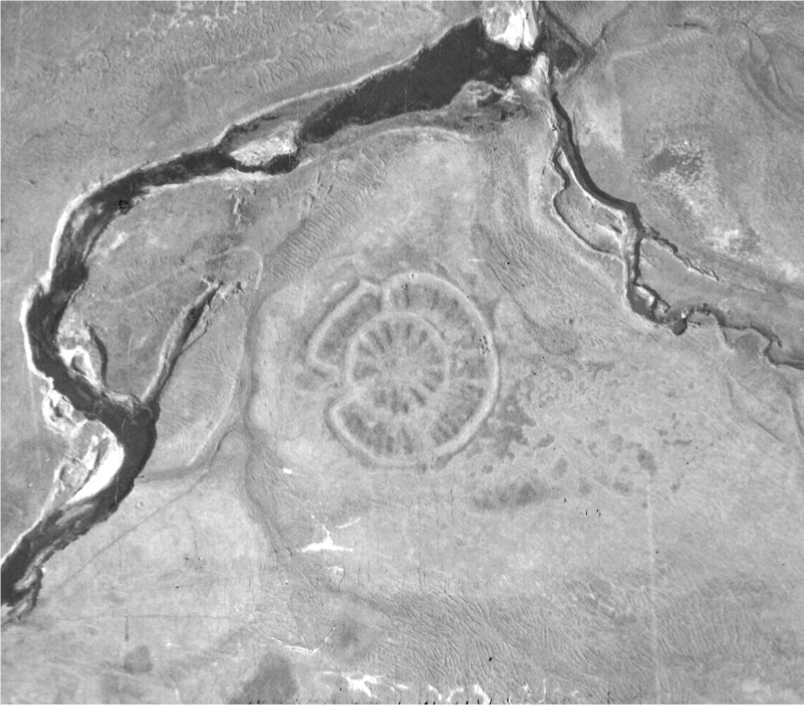
Fig. 5 (photo). Aerial view of the fortified circular settlement Arkaim, taken in 1978 (after [Зданович, Батанина, 2007]
Yet, when taking the hollows in the ground east and northwest in front of the settlement as well as the cultural layers attested in the west into account, the archaeologically relevant area consists of at least 60,000 m2. Compared directly with other structures in the Eurasian steppe, settlements of the Sintashta culture display a remarkable complexity and can be divided into three basic architectural types [Зданович, Батанина, 2007. C. 184–192; Koryakova, Epimakhov, 2007. P. 68].
The first two types of settlement are characterised by oval or round outlines with radially arranged houses, whose entrance is directed towards the centre of the settlement. The third type, opposite the first two, constitutes settlements with a rectangular fortification system, in which the houses were incorporated.
Research has often viewed these types as a sequence, typologically as well as chronologically, which began with the oval structures and ended with the rectangular ones. The enclosed settlement space covered between 6000 m2 to an astounding 35,000 m2 [Koryakova, Epimakhov, 2007. P. 69].
The defence walls were mostly built in the characteristic wood-and-earth construction, for which a wooden framework based upon a foundation of sod and local stone served to stabilise the standing walls [Генинг и др., 1992. С. 39. Рис. 12]. When completely dried, the walls had a cement-like quality! In this way, the walls could reach a height of 5–6 m.
The houses in settlements of oval or round plan were mostly arranged in a concentric circle along the fortification walls. The long side of one house often touched on that of the neighbouring house and the outer gable with the fortification wall. The centre of settlement, conversely, was almost void of any kind of construction. As the example of Arkaim shows (fig. 5), however, clearly more complex divi- sions of the available space were undertaken. For instance, an additional inner boundary wall was erected in Arkaim, to which a second ring of radially arranged houses joined [Зданович, 1997. С. 48. Рис. 1, 50; 3; Зданович, Бата-нина, 2007. С. 44. Рис. 13].
The rectangular or trapezoid houses correlate in size with the dimensions of the respective settlement and their ground plans range between 100 m2 and 250 m2 [Koryakova, Epimakhov, 2007. P. 72]. However, only a small part of this surface served for actual domestic use, as in many cases one well or even several wells were located within the structures; in addition, the remains of domed ovens with traces of metalworking appeared next to them too. The walls of the wells were lined with a wattle framework, and the average depth of the well shaft reached down to 5 m, in relation to the local level of groundwater (fig. 6).
By means of the magnetogram (fig. 7) made during the excavation of 2009 the outline of the inner division and the number of houses inside the settlement could first be determined [Krause et al., 2010. S. 108–111]. It revealed 25 or 26 houses in the northern half of Kamen-nyi Ambar, which stood along two narrow parallel axes; the row of houses in the centre were built apart. One or more anomalies were visible in the back third of each house. Most likely they constituted wells, hearths and oven structures. A surprising context was that of a distinct two-part division of the fortification and the settlement, which could indicate a succession in construction. Likewise thought-provoking is above all the circumstance that no houses could be determined in the southern area extending to the river, but instead numerous pits or groups of pits. Nonetheless, until now there is no explanation for what could have been found there. Conceivably this was an «activity zone», for example, of crafts, metalworking or various other handiwork that was connected with agricultural production or with stock-raising.
Aside from the geomagnetic measurement in Kamennyi Ambar, initial measuring was made in two other settlements in the vicinity, Zhurumbaj und Konoplyanka [Ibid. S. 110]. These brought forth good results as well, revealing the structures of the settlement, including the house units themselves. Until now, the Russian-German excavations have concentrated on the northern part of the fortifications at Ol-gino, whereby several houses and above all numerous well could be unearthed in two large areas.
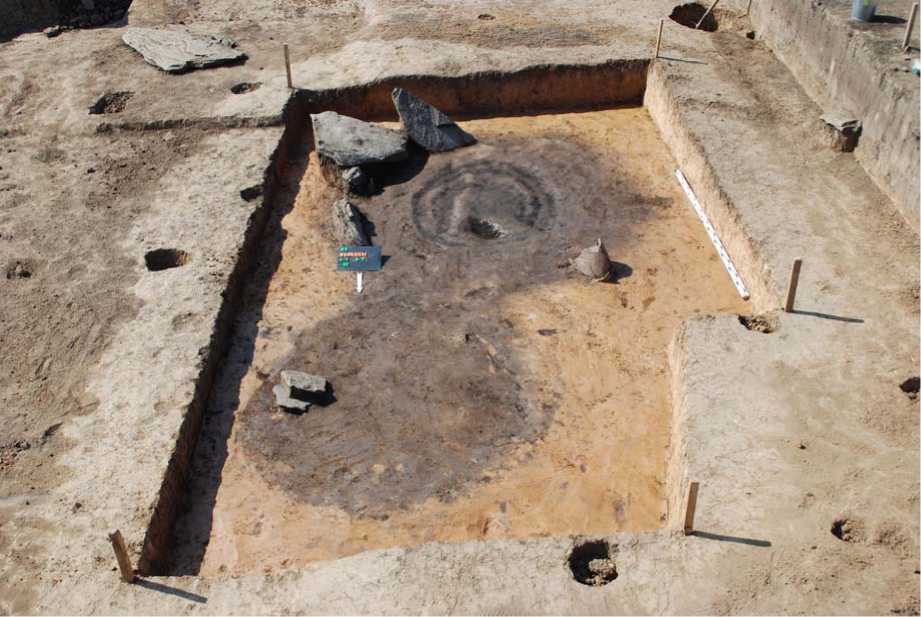
Fig. 6 (photо) . Excavation section 6 of Kamennyi Ambar (Olgino); wells: 4/1 (front), 6/1 (back) (view from North side)
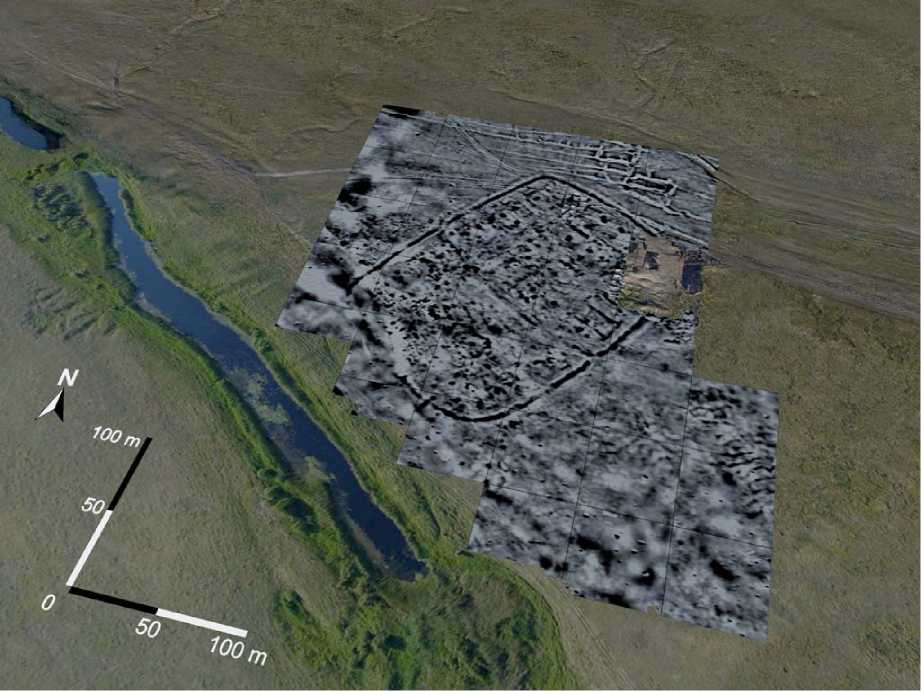
Fig. 7 (combined). Kamennyi Ambar (Olgino); contour map of the settlement area including magnetogram (done in 2009)
Thereby, the work succeeded in recovering the remains of the original wood lining inside several well. In one case this involved a well house built of wattle, in another case a well house lined with vertically split, pointed logs. Moreover, in the summer of 2010 wooden artefacts could be retrieved from the fill of the well. At present, they are undergoing conservation and still await thorough analysis. Due to the small number of tree rings in the wood ob-jects/artefacts at hand, it has not been possible to carry out dendrochronological analyses on the samples yet. Nevertheless a series of AMS radiocarbon datings could be gained from the wood (fig. 8). Six calibrated radiocarbon datings from two pieces of wood out of two wells each resulted in dates in an interval between 2100–1900 cal BC. With that, the series of dates obtained from the wood in the wells shows a tendency towards being older than the dates gained from human bones from the nearby kurgan at Kamennyi Ambar 5, with a date-interval of 1960–1770 cal BC. For the future it is planned to expand this series of datings by including different contexts and materials in order to set up an independent chronological framework [Епимахов и др., 2005; Hanks et al., 2007].
An essential and integral factor for understanding the landscape and the subsistence strategies is supplied by geomorphological, pedological and archaeobotanical investigations [Krause et al., 2010. S. 118–123]. In this vege-tational and climatic zone their line of inquiry concerns the extent to which an economy of stock-raising and herding could be supplemented with agriculture and the cultivation of food plants. In pursuing the question about crop cultivation, many samples from the cultural layers were systematically wet-sieved during the excavations in order to obtain larger charred remains of plants. The charred plant material proved to be relatively well preserved and also quite varied. Most of the species identified
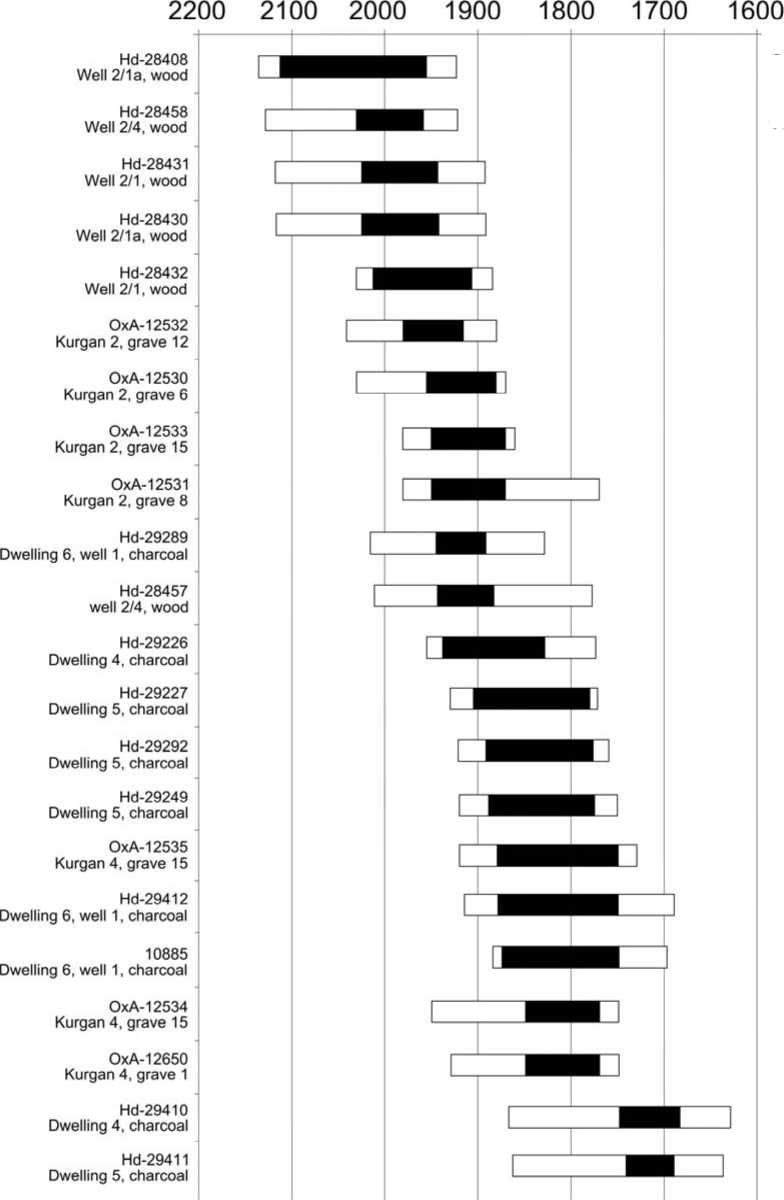
cal BC
С14 data from the settlement Ol'gino and the kurgan necropolis Kammenyi Ambar
Fig. 8 . 14C-data from the necropolis and the settlement of Kamenyi Ambar (Olgino)
came from the feather-grass-steppe; the charred cereal grains have not been identified yet. The choice of some species, especially non-culti-vated legumes, indicates that the Bronze Age inhabitants gathered specific plants from far-a-field (see Kalis, Stobbe this volume).
Initial palynological evaluations show that during the entire Holocene the valley of the Karagaily-Ayat was likely covered by typical steppe vegetation, with Artemisia predominating and alternating with clusters of woods. The spectrum of pollen types was relatively small during the early Holocene (the hitherto oldest 14C dated sediment formed in ca. 7500 BP), but increased in the course of time. Then marked changes can be noted in the regional as well as local pollen sediments, which – according to the present state of knowledge – are associated with anthropo-zoogenic activities [Krause et al., 2010. S. 121].
Until now the ‘sought-for’ cereal grains are absent. By contrast pollen seeds of the cereal type are attested, but their chronological assignment to cultural layers is still lacking. Do the pollen seeds represent the cereals that were cultivated? Or do they stem from wild grasses? So, whether or not cereals were already cultivated remains an interesting question.
Without doubt stock-raising played a major role in the economy. Fortunately animal bones found in Kamennyi Ambar (Olgino) are well preserved and form a good basis for archaeozo-ological examination. Until now they comprise more than 20,000 bones, of which the first part derives from layers of the Sintašta period, excavated in 2005/2006 under the direction of Dr. P. Kosintsev. The bone inventory includes: 51 % cattle, 38 % sheep/goat and 5 % horse. Archaeozoological studies are a further and promising contribution towards reconstructing reciprocal relations between human beings and the environment in this region.
In summarising, let us state the following: The fortified settlements of the Sintashta culture, located on the northern periphery of the vast Eurasian steppe, an important crossroads between east and west, left behind distinct traces in the ground after a comparably short time span (transition from the 3rd to the 2nd millennium BC). There are still many questions pertaining to the genesis and structure of these fortified sites and of Sintashta society, all of which are of significance for understanding this remarkable Bronze Age culture in the TransUrals. In the area under study three fortified settlements lie along the small Karagaily-Ayat river. Recent magnetogramms and excavations show all of their details, such as house plans and the position of wells. These new data are well suited for constructing models about the population in particular and about social structure in general. The number of house units, some 25/26 in Kamennyi Ambar and 21 in Ko-noplyanka, made it possible to reconstruct the size of population, according to which around 200–300 persons presumably lived in each settlement. Together with results and parameter from natural scientific investigations, these data form an important basis for models on the population in the surroundings or catchment area of a settlement and ultimately to gain an impression of the number of people who could have lived in the area of the fortified settlement.
The Russian-German cooperation project has the immense opportunity through interdisciplinary direction to create a substantially new basis for understanding the society, development and history of the Sintashta culture.
Translated by Dr. Emily Schalk, Berlin
ФАКТОР ОКРУЖАЮЩЕЙ СРЕДЫ В ИЗУЧЕНИИ КУЛЬТУРНОЙ ВАРИАТИВНОСТИ – ПО МАТЕРИАЛАМ ЗАУРАЛЬЯ
В основе совместного Российско-Германского проекта, осуществляемого специалистами Российской академии наук (г. Екатеринбург) и университета им. Гете (г. Франкфурт-на-Майне), – междисциплинарное изучение укрепленных поселений синташтинской культуры эпохи бронзы. Задачи исследований – вопросы генезиса поселений данного типа, природно-климатические условия и экономические факторы. С целью поиска возможных изменений степных ландшафтов археологические раскопки и разведочные обследования дополняются изучением растительности. Геоморфологические и почвенные исследования позволят определить возможные изменения почв с точки зрения их использования в качестве пастбищ или для земледелия, а также осветить некоторые общие вопросы землепользования и культурогенеза. Магнитометрическое изучение поселений с последующей верификацией археологическими раскопками дает возможность определить планиграфию жилищ и колодцев. Все вместе открывает новые интерпретационные возможности для определения как численности населения поселений, так и для реконструкции социальных структур.
Kлючевые слова : Зауралье, эпоха бронзы, синташтинская культура, окружающая среда, геомагнитное изучение, дендрохронология, поселения.

